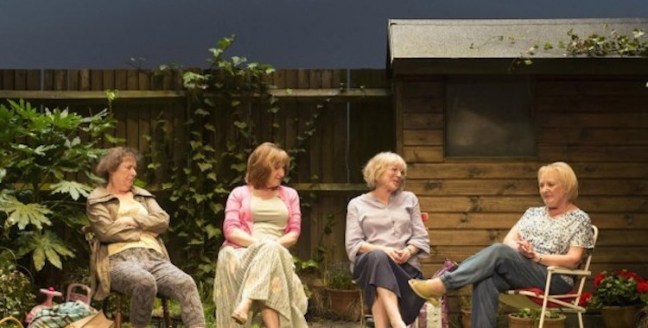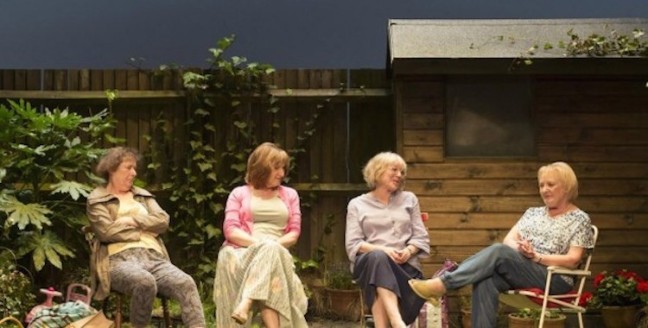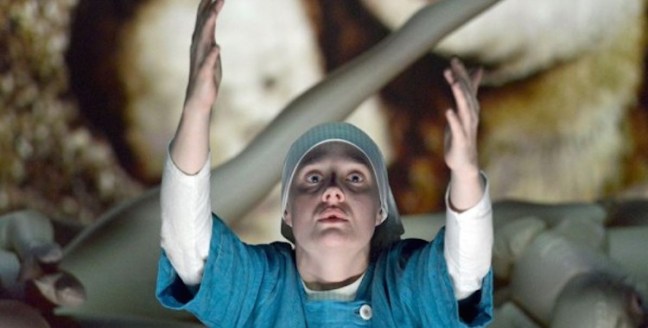In writing about this production, I’ve taken something of a counter-intuitive approach – or if not counter-intuitive, then certainly counter to conventional critical practice. I saw the show before Christmas without any intention of writing about it, subsequently discussed it in a seminar group, read all the reviews I could get my hands on, and feverishly combed my way through the script. Essentially, I pursued my fascination with the piece down every avenue other than writing about it, before deciding (some time after the production closing) that I was going to have to write about it after all. As a result, what follows is at least partly the product of osmosis …
“Happiness is never experienced, only remembered” – Oscar Levant
The above quote, unexpectedly dredged up from the depths of my memory somewhere, seems like a fitting place to start. If happiness is an emotion that can’t be fully experienced in the present, then in today’s society it is a sensation that is not so much remembered as shared. Whether via social media updates, glossily vacuous magazine interviews or the compulsive confessionals of reality television, emotion has become currency, a commodity to trade in the continual search to define one’s identity. It is this obsessive cult of the individual (among other things) that is interrogated, prodded and mercilessly skewered by Martin Crimp’s latest play.
It strikes me that the two key words that frame the piece – ‘republic’ and ‘happiness’ – seem in many ways to be internally opposed. So long as the quest for individual happiness continues to be sold to us as the ultimate goal of our existence, a goal to be pursued at the exclusion of all others, the possibility of cooperation is precluded and the true democracy implied by the concept of the ‘republic’ is rendered impossible. This can be read as the rotten truth buried beneath government happiness indexes and aspirational marketing speak; the tyranny of the individual is not one that frees us at all, but one that traps us in an isolating and self-perpetuating state of immobility, speaking in the same blithely inane circles as Crimp’s empty characters.
The play itself is divided into three distinct sections: ‘Destruction of the Family’, ‘The Five Essential Freedoms of the Individual’ and ‘In The Republic of Happiness’. Before delving into each of these, I’d suggest that the number of scenes feels significant, although the nature of this significance is uncertain. As Andrew Haydon touches on in his review, the number three invites numerous possible readings, with other critics positing the heaven, hell, purgatory trio (though I’d struggle to decide which section might be interpreted as which), while Andrew suggests that past, present and future works just as well. Vaguely linked to that chronological conception of the structure, I might add the traditional three-act play. For a piece that in many ways disrupts and deconstructs theatrical conventions from within, I suspect it’s no accident that it defers to and then explodes this most accepted of stage constructs.
The play also has the intriguing subtitle ‘an entertainment in three parts’, immediately summoning the inform/entertain binary and also begging the question of what exactly we find entertaining. We might further ask whether this production can indeed be classed as entertainment at all – it’s certainly very enjoyable in parts, but it’s hardly the comfortable viewing that we might normally associate with the traditional genre of ‘entertainment’. (As an aside, Dan Hutton interestingly suggests that the production has the quality of a “variety show where the theme is ‘what it means to be happy'”, pointing to the mixture of dramatic styles and the inclusion of songs as displaying a sort of vaudevillian influence)
As another brief preface to my discussion of the three sections, it feels necessary and helpful to set this production within its context. Showing at the Royal Court near the end of Dominic Cooke’s time as artistic director, there are a very specific set of implicit social, economic and artistic referents that frame the piece, which has a distinctly self-reflexive tint. The position of the theatre in Sloane Square’s bubble of privilege, its particular theatrical history and its typical audiences are all variously called to mind, as is Cooke’s frequently cited remit of exploring the position of the middle classes.
Which leads conveniently into the first section, ‘Destruction of the Family’, with its initial set-up recalling so many of the plays that have characterised Cooke’s artistic leadership of the theatre. At first glance, the scene conjures a typical (if slightly bare and a little unsettlingly red in colour) middle class dining room, furnished with a seemingly typical middle class family. Any notion of the ‘typical’ soon slips away as a superficial naturalism steadily crumbles, but the opening domestic image is quietly clever in its manipulation of audience expectations, as well as convincing me that Cooke (who has directed this piece) might just have a sense of humour about the supposed middle class obsession of his tenure.
The premise of this opening scene is a family Christmas dinner which is interrupted by the arrival of the apparently estranged Uncle Bob, whose appearance violently shatters a naturalism that has been gently eroding from the start. There’s a strain of heightened, compulsive truth-telling to the dialogue early on, quickly setting up a sense of dislocation, while the intrusion of a strange and unsettling song from the family’s two teenage daughters further arouses suspicions that all is not as it seems. Script and production both mark Uncle Bob’s entrance as a caesura, with the character’s assertion that “I thought I would just suddenly appear, so I did” and actor Paul Ready’s startling emergence from an invisible doorway both contributing to the sense Dan Rebellato articulates of this figure being a fictional construction abruptly summoned into being (which of course he is).
This initial aura of meta-theatrical fiction surrounding the character is reinforced later on. Uncle Bob’s reason for interrupting, he tells the family, is to inform them what his girlfriend Madeleine thinks of them all before the pair jet off to start a new life that is “like a pane of glass” – “Hard. Clear. Sharp. Clean”. While reeling off a litany of escalatingly vile insults, Bob says at one point: “you think I get pleasure from having to stay here and repeat what another person has instructed me to say?” While in one straightforward reading he is referring to the string-pulling off-stage presence of Madeleine, it’s hard to shake the feeling that this is not also directed at the creative control of the playwright, an alternative reading that is enhanced in production by Ready’s implicit awareness and acknowledgement of the audience.
The breakdown of naturalism briefly outlined above, a process of collapse that begins from within, is eventually reflected in Miriam Buether’s design, as the noticeably flimsy walls of the room that contains the first section are pulled away – a visible dismantling. While this happens in the transition between the first and second sections, the cast line up facing the audience and very deliberately remove items of their costume – earrings here, a jacket there. It’s a calculated and conscious move, stripping away certain signifiers of character but letting other vestiges remain. What we are left with are figures who exist somewhere disturbingly between character and actor, acknowledging the ghosts of the characters they have just left behind and carrying these lingering spectres into the second segment of the show.
This is the longest and (at least in my experience) most enjoyable portion of the production. An excoriating satire, the section consists of, as announced in the title, ‘The Five Essential Freedoms of the Individual’: ‘The Freedom to Write the Script of My Own Life’, ‘The Freedom to Separate My Legs (It’s Nothing Political)’, ‘The Freedom to Experience Horrid Trauma’, ‘The Freedom to Put It All Behind Me and Move On’, and ‘The Freedom To Look Good & Live For Ever’. These take the form of a long stream of lines, which I later learned are completely up for grabs among the cast; each of the actors knows the entire thing and each night they were all free to take whichever lines they felt compelled to. This produces slippery and ever-shifting meanings, overlaying the words themselves with an engaging interplay between theatrical signifiers (how does this young female actor taking the line inflect it in a different way to an older male actor? what is the relationship between the words being spoken and the characters from the first act that have just been discarded?).
Crimp’s targets in this long (possibly over-long) section are many and varied: resolutely anti-political individualist rhetoric, the modern obsession with personal wellbeing, the fetishisation of trauma and recovery, the desire to control the story of one’s own life – all peppered with more specific references to modern day phenomena such as airport security checks and child medication, and broken up by a series of songs. It’s difficult throughout this stinging assault to pin down quite where Crimp himself (and by extension the whole production) stands, as the satire is quick to turn on the opposite viewpoint, upturning audience assumptions as fast as they form. (An example: “I don’t say I’m happy to separate my legs so that people who’ve been educated in a certain way or have particular beliefs can sit here in this audience and think that I mean the opposite – no way”. Ouch.)
The staging here, as Andrew suggests, is not particularly revelatory (he dubs it “The Path of Least Resistance”). Tugging at the unifying thread of the individual enshrined at the centre of contemporary culture, the organisation of the stage suggests the television chat show, with the cast lined up on clinical white chairs in front of a screen, while the mic-clutching performance style of the punctuating songs evokes the likes of The X Factor. This in itself might be telling; immediate associations are culturally revealing, in this instance speaking of the ubiquity of celebrity. This implicit context does, however, align readings in a certain way, whereas the lines as written on the page, without any direction or attribution, invite any number of different interpretations; much like seeing the Royal Court’s enjoyable but fairly unimaginative staging of Love and Information and subsequently reading Caryl Churchill’s startlingly open text, I was immediately itching to see someone else get their hands on it.
After thoroughly roasting our self-obsessed modern preoccupations, the middle section gives way to the final, most challenging segment of the production. Via an impressive scene transition during which a large white cube rises from beneath the stage, we return to Bob and Madeleine, who are now in an unspecified, antiseptic republic of which Bob appears to be the head – although it is once again Madeleine who pulls all the strings. Whereas prior to this the production gives us something to grasp onto, even if that something is a convention that cracks beneath our grip almost as soon as our fingers close around it, this concluding scene casts everything into doubt. This state of uncertainty goes right down to the design, which leaves an unsettling gap either side of the white cube in which Bob and Madeleine are standing, exposing the unattractive seams of the theatrical event and situating us in an unstable in-between territory, stranded somewhere that is not quite illusion yet not quite its opposite. Just as the middle section presents us with figures who hover between character and performer, theatrical conventions and signifiers cannot be relied upon.
On first watching it, I honestly wasn’t sure what to make of the closing scene, and I’m still not really sure about it. No characters inhabit the scene other than Bob and Madeleine and the minimal design seems calculated to give as few interpretive footholds as possible. We might assume that they have established the life that they dreamed of in the first scene – “like a pane of glass” – and it certainly seems to fulfil Madeline’s desire for a shallow surface shimmer, clean and shiny but devoid of depth. Though where exactly they are (other than, presumably, the unspecified ‘republic of happiness’) is anyone’s guess; Bob’s demand to know where the world has gone suggests that there might be nothing beyond the clinical cube they occupy, but I don’t have many other guesses to proffer. As has probably become clear, I struggled with this scene, and not necessarily in an enjoyable way. I think I probably agree with Andrew that it’s the sudden shift into total, almost impenetrable metaphor that is most frustrating and baffling about this gear change.
One possible way of reading this conclusion is as a critique of happiness itself. Dan Rebellato suggests that there is “something deeply banal about measuring fulfilment through happiness” and comes at the scene from this perspective, seeing happiness as a shallow category of experience. There certainly seems to be something in this when we look at Bob’s closing song, the ‘100% Happy Song’, an eerie and hollow tune that draws on nursery rhyme but drains the form of all its childish cheer. As Bob joylessly intones his final “oh hum hum hum the happy song”, it’s easy to agree with Dan that this last act “captures the thinness of a purely happy world”.
For me, despite my difficulties with interpreting the scene as a whole, its look and feel crystallized a certain set of ideas that can be identified running through the entire play. With its white finish and the flat, lifeless landscape of green visible through the large window, the set in this final scene has something of the Microsoft Windows interface to it, while the cube’s striking similarity to the design for Love and Information (also Buether’s, incidentally) immediately conjured for me that play’s attention to the digital information onslaught. Throughout In The Republic of Happiness, the characters seem to either inhabit or wish they inhabited a virtual world, one centred on the individual and logically cleansed of all life’s awkward complications – a defragmented existence. Madeleine wants to be able to select Bob’s family and click delete; there is talk of opening the document of one’s life; the lines of the middle section express a recurring obsession with fact, that most beloved item of the information age; the ‘100% Happy Song’ encourages listeners to “click on my smiling face”.
This entanglement with and desire for the digital experience seems wrapped up in the piece’s two other central concerns: the contrast between surface and depth and the pervading obsession with self. The screen is perhaps the ultimate expression of surface; not only shiny, hard and reflective, but also promising an existence that allows the destruction of depth, enabling users to delete files from their lives with just a click. Digital outlets also elevate the importance of the individual, offering each of us the possibility of transmitting a self-edited version of ourselves to the world. This extreme narcissism is most emphatically embodied in the figure of Madeleine, a character so wrapped up in herself that even her dress makes her feel like “I’m zipped into my own vagina”, and whose calculated, self-aware portrayal by the excellent Michelle Terry suggests an individual in love with the performance of her own life. Perhaps, we might conclude, it is the atomising force of our reliance on digital communication in the modern world that has engendered the cult of the individual that the play satirises, though I doubt Crimp’s diagnosis is quite that simple.
Inevitably, there’s a lot more that could be teased out from this production that I’ve barely touched on or that has emerged in reflection over the weeks since seeing it. One recurring element noted by Andrew that I hardly picked up on at all while watching is the repetition of references to child abduction and sexual abuse, though I’m not entirely convinced by Andrew’s suggestion that the structure of the play performs the function of “purging” Uncle Bob of hinted sexual crimes against his two nieces. I also felt the faint but looming shadow of environmental disaster hanging over the piece, lightly alluded to in teenager Debbie’s fear of the future, the family’s energy-saving removal of lightbulbs in the first scene and Granny’s premonition that humanity is on the brink of massive change; more of a background presence than a key concern, but one that has troubling implications for the narcissistic individualism at the play’s core, perhaps suggesting that our atomisation is key to our inability to cooperate in order to avert crisis.
Picking up on Bob’s stubborn insistence that “it goes deeper than that”, Dan Hutton proposes that this play also begs us as audience members and critics to go deeper, peeling away layers of meaning and theatricality. “No matter how much we think we ‘get it’,” he suggests, “we must continue to dig”. So essentially this is me attempting to excavate, to move beyond the surface and dig deeper. Though, despite all my interpretative efforts, it probably still goes a lot deeper than that.





